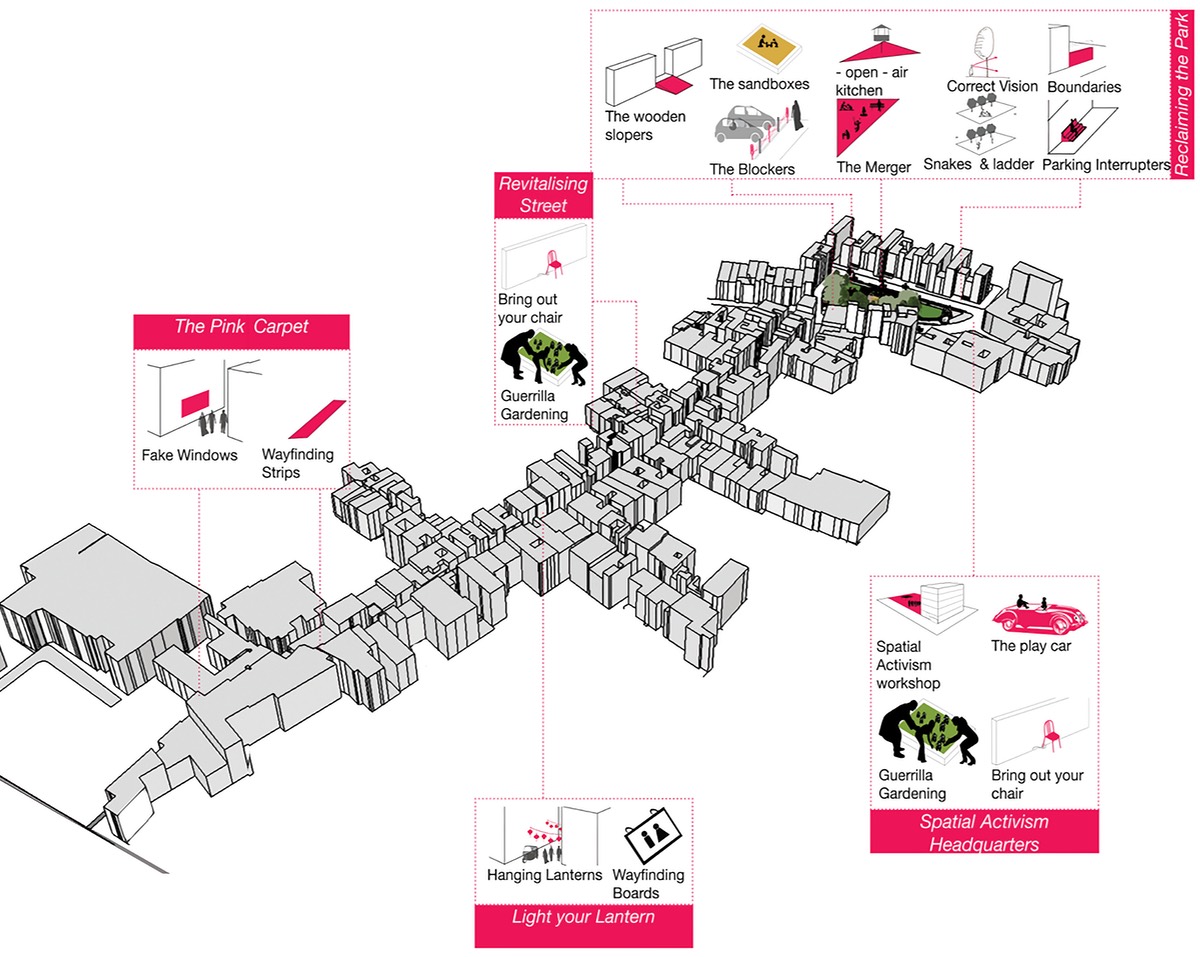Designing for the re-appropriation of public spaces by women in New Delhi, India
Downloads
DOI:
10.31182/cubic.2019.2.019Keywords:
gender sensitive urban design, spatial activism, community building, citizen participation, stakeholder coalitionAbstract
The first attempt to reinvent the public spaces, #WomenSpatialActivism, reclaims the women’s right to the city in India. Women Spatial Activism (WSA) proposes a gender-sensitive approach to urban design in the neighbourhood of Malviya Nagar in Delhi in India, that inspires the reappropriation of the front door by an old woman, the street by a working girl and the public park by mothers. The proposal is to reclaim women’s right to the city through the recontextualisation of their public spaces which have been lost or need to be developed in urbanised India. The project has three main components: bottom-up strategic spatial interventions, the creation of a strong coalition of local stakeholders, and the use of digital technology. The hashtag #WomenSpatialActivism or #WSA aims to spread this movement through social media. The Women Spatial Activism project calls for a spatial gender agenda for an inclusive urban future for all.
How to Cite
Published
Issue
Section
License
Copyright (c) 2020 Sugandha Gupta, Luisa Calabrese, Akkelies van Nes

This work is licensed under a Creative Commons Attribution 4.0 International License.
References
Agarwal, Shaifali. “Women Walk Alone to Reclaim India’s Streets from Fear and Harassment.” The Guardian, August 26, 2016. Accessed January 31, 2019. https://www.theguardian.com/global-development/2016/aug/26/women-walk-alone-blank-noise-india-reclaim-streets-fearharrassment
Abdelbaseer, Mohamed and Akkelies van Nes. “Towards safer greater Cairo. An investigation of Space and Sexual Harassment.” In Proceedings of the 11th international space syntax symposium. Edited by T. Heitor, M. Serra, J. P. Silva, M. B. Carreira, L. C. Da Silva, and E. Bazaraite. Lisbon, 2017.
Arendt, Hannah. The Human condition. Chicago: Chicago University Press, 1958.
Beebeejaun, Yasminah. “Gender, Urban Space, and the Right to Everyday Life.” Journal of Urban Affairs 39, no. 3 (2017): 323-334. DOI: https://doi.org/10.1080/07352166.2016.1255526
Dobbs, Richard, James Manyika, Jonathan Woetzel, Michael Chui, and Susan Lund. The Power of Parity: How Advancing Women’s Equality can Add $12 Trillion to Global Growth.
McKinsey Global Institute: 2015. https://www.mckinsey.com/~/media/McKinsey/Featured Insights/Employment and Growth/How advancing womens equality can add 12 trillion to global growth/MGI Power of parity_Full report_September2015.ashx
Butler, Judith. Gender trouble: Feminism and the subversion of identity. New York: Routledge, 2006.
Fenster, Tovi. “The Right to the Gendered City: Different Formations of Belonging in Everyday Life.” Journal of Gender Studies 14, no. 3 (2005): 217-231. DOI: https://doi.org/10.1080/09589230500264109
Gehl, Jan. Life Between Buildings: Using Public Space. Washington: Island Press, 2011.
Greed, Clara. Women in Planning, Creating Gendered Realities. London: Routledge, 1994.
Green, Duncan. “Great new IMF paper puts women’s rights at the heart of tackling income inequality.” Oxfamblogs. Last modified November 10, 2015. Retrieved January 31, 2019. https://oxfamblogs.org/fp2p/the-imf-tackles-genderinequality/
Gupta, Sugandha. “#WomenSpatialActivism: An urban designer's approach towards re-appropriation of spaces by women in New Delhi, India.” Master’s thesis, Delft University of Technology, 2017.
Hayden, Dolores. “What Would a Non-Sexist City Be Like? Speculations on Housing, Urban Design, and Human Work.” Signs: Journal of Women in Culture and Society 5, no. 3 (1980): S170-187. DOI: https://doi.org/10.1086/495718
Hillier, Bill and Ozlem, Sahbaz. “An Evidence Based Approach to Crime and Urban Design Or, Can We Have Vitality, Sustainability and Security All at Once?” Thesis, Bartlett School of Graduate Studies, University College London, 2008.
Jacobs, Jane. The Death and Life of Great American Cities. New York: Vintage Books, 1992.
Jagori. Safe Cities for Women and Girls Recent Developments. New Delhi: Jagori, 2016. Accessed January 31, 2019. http://www.jagori.org/sites/default/files/publication/SAFE_CITIES_FOR_WOMEN_AND_GIRLS_0.pdf
Lawton, Carol A. and Janos Kallai. “Gender Differences in Wayfinding Strategies and Anxiety About Wayfinding: A Cross-Cultural Comparison.” Sex Roles 47, no. 9-10 (2002): 389-401. https://doi.org/10.1023/A:1021668724970 DOI: https://doi.org/10.1023/A:1021668724970
Lefebvre, Henri. Writings on Cities. Cambridge, Massachusetts: Wiley-Blackwell, 1996.
Lynch, Kevin. The Image of the City. Cambridge, Massachusetts: MIT Press, 1972.
Nag, Diya. “For Women Living Alone in Delhi, Security Concerns Heightened – The Asia Foundation.” Asia Foundation. Last modified 2 March 2016. Accessed January 31, 2019. http://asiafoundation.org/2016/03/02/for-womenliving-alone-in-delhi-security-concerns-heightened/
Paul, Tanusree. “Space, Gender, and Fear of Crime: Some Explorations from Kolkata.” Gender, Technology and Development 15, no. 3 (2011): 411-35. DOI: https://doi.org/10.1177/097185241101500305
Phadke, Shilpa, Shilpa Ranade, and Sameera Khan. “Why Loiter? Radical Possibilities for Gendered Dissent”. In Dissent and Cultural Resistance in Asia’s Cities. Edited by Melissa Butcher and Selvaraj Velayutham. London: Routledge, 2009. 185-203.
United Nations. “Habitat III: New Urban Agenda.” United Nations Conference on Housing and Sustainable Development, Quito, Ecuador, 2016. Accessed January 31, 2019. http://habitat3.org/wp-content/uploads/Habitat-III-New-Urban-Agenda-10-September-2016.pdf
Safetipin. “Safeitpin: supporting safer cities.” http://safetipin.com/. Accessed January 31, 2019.
UN Habitat Worldwide. “SO3EO3 Gender Perspectives in Urban Planning”. Posted Feburary 12, 2016. Youtube video, 14:16mm, https://www.youtube.com/watch?v=Sop4fqc2NV8. Accessed, January 31, 2019.
Tharu, Susie and Tejaswini Niranjana. “Problems for a Contemporary Theory of Gender.” Social Scientist 22, no. 3/4 (1994): 93-117. DOI: https://doi.org/10.2307/3517624
van Nes, Akkelies and Tra My Nguyen. “Identifying the spatial parameters for differences in gender behaviour in built environments. The flâneur and flâneuse of the 21st century.” Territory of Research on Settlements and Environment. International Journal of urban planning culture, no. 10 (2013). http://dx.doi.org/10.6092/2281-4574/1554
van Nes, Akkelies and Lisa de Rooij. “The perceived safety and spatial behaviour in three different neighbourhoods in Rotterdam.” In Proceedings of the 10th international space syntax symposium. Edited by K. Karimi, L. Vaughan, K. Sailer, G. Palaiologou and T. Bolton. London: Space Syntax Laboratory, The Bartlett School of Architecture, UCL, 2015. 139:1-139:19.
Vishwanath, Kalpana and Ashish Basu. “SafetiPin: an innovative mobile app to collect data on women’s safety in Indian cities”. Gender & Development 23, no. 1 (2015): 45-60. DOI: https://doi.org/10.1080/13552074.2015.1013669
Viswanath, Kalpana and Surabhi Tandon Mehrotra. “Shall We Go Out? Women’s Safety in Public Spaces.” Economic and Political Weekly 42, no. 17 (2007): 1542-1548.
Woodsworth, Ellen. “Making Space for Women in Cities.” Focus on Space, Winter 2005. Vancouver, B.C.: Newsletter produced by the Social Planning and Research Council of B.C.

